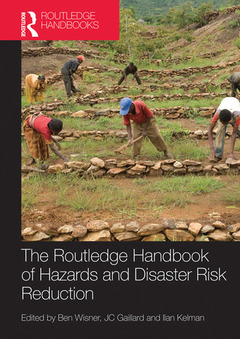Handbook of Hazards and Disaster Risk Reduction
Coordonnateurs : Wisner Ben, Gaillard J.C., Kelman Ilan

The Handbook provides a comprehensive statement and reference point for hazard and disaster research, policy making, and practice in an international and multi-disciplinary context. It offers critical reviews and appraisals of current state of the art and future development of conceptual, theoretical and practical approaches as well as empirical knowledge and available tools.
Organized into five inter-related sections, this Handbook contains sixty-five contributions from leading scholars. Section one situates hazards and disasters in their broad political, cultural, economic, and environmental context. Section two contains treatments of potentially damaging natural events/phenomena organized by major earth system. Section three critically reviews progress in responding to disasters including warning, relief and recovery. Section four addresses mitigation of potential loss and prevention of disasters under two sub-headings: governance, advocacy and self-help, and communication and participation. Section five ends with a concluding chapter by the editors.
The engaging international contributions reflect upon the politics and policy of how we think about and practice applied hazard research and disaster risk reduction. This Handbook provides a wealth of interdisciplinary information and will appeal to students and practitioners interested in Geography, Environment Studies and Development Studies.
Foreword 1. Challenging Risk: We Offer the Reader a Left Foot Book Section 1: Big Picture Views – Hazards, Vulnerabilities and Capacities 2. Introduction to Section 1: Big Picture Views – Hazards, Vulnerabilities and Capacities 3. Framing Disaster: Theories and Stories Seeking to Understand Hazards, Vulnerability and Risk 4. Historical Concepts of Disasters and Risk 5. Politics; power and disasters6. Human Rights, Disasters and State Obligations 7. Violent Conflict, Natural Hazards and Disaster 8. Culture, Hazard and Disaster9. Knowledge and Disaster Risk Reduction10. Religious Interpretations of Disaster11. Hazards and Disasters Represented in Film12. Hazards and Disasters Represented in Music13. Hazard, Risk and Urbanisation 14. Disaster Risk and Sustainable Development Section 2: Fine-Grained Views – Hazards, Vulnerabilities and Capacities 15. Introduction to Section 2: Fine-Grained Views – Hazards, Vulnerabilities and Capacities16. Data Sources on Hazards17. Tools for Identifying Hazards18. Hazard, Risk and Climate Change19. Coastal Storm 20. Thunderstorm and Tornado 21. Flood22. Drought23. Extreme Heat and Cold24. Wildfire 25. Landslide and other Mass Movements26. Earthquake 27. Tsunami28. Volcanic Eruption29. Soil Erosion and Contamination30. Human Epidemic31. Livestock Epidemic32. Plant Disease, Pests and Erosion of Biodiversity 33. Hazards From Space 34. Disability and Disaster35. Gender, Sexuality and Disaster36. Children, Youth and Disaster37. Elderly People and Disaster38. Caste, Ethnicity, Religious Affiliation and DisasterSection 3: Preparedness and Response 39. Introduction to Section 3: Preparedness and Response 40. Early Warning Principles and Systems41. Preparedness, Warning and Evacuation42. Emergency Management Principles43. From Damage and Needs Assessments to Relief44. Health Care and Disaster45. Food Security and Disaster46. Settlement and Shelter Reconstruction47. Psycho-Social Recovery48. Socio-Economic RecoverySection 4: Planning, Prevention and Mitigation 49. Introduction to Section 4: Planning, Prevention and Mitigation 50. International Planning Systems for Disaster51. National Planning and Disaster52. Local Government and Disaster53. Urban and Regional Planning and Disaster54. Financial Mechanisms for Disaster Risk55. Economic Development Policy and Disaster Risk56. Protection of Infrastructure57. Social Protection and Disaster58. Livelihood Protection and Support and Disaster 59. Community Action and Disaster 60. Civil Society and Disaster61. University Research’s Role in Reducing Disaster Risk62. Education and Disaster63. Media, Communication and Disaster64. Participatory Action Research and Disaster Risk Section 5: Conclusion 65. Challenging Risk: Has the Left Foot Stepped Forward?
Ben Wisner is a retired Professor who has worked on the interface between disaster risk reduction and sustainable human development since 1966. He currently conducts research and advises institutions such as the Global Network of Civil Society for Disaster Reduction.
JC Gaillard is Senior Lecturer at the School of Environment of The University of Auckland, New Zealand.
Ilan Kelman is a Senior Research Fellow at the Center for International Climate and Environmental Research–Oslo (CICERO).
Date de parution : 12-2011
17.4x24.6 cm
Date de parution : 12-2011
17.4x24.6 cm
Thème de Handbook of Hazards and Disaster Risk Reduction :
Mots-clés :
FEMA; handbook of hazards and disaster risk reduction; UNISDR 2005b; handbook of harzard; UNISDR 2010a; Ben Wisner; Tamil Nadu; JC Gaillard; DRR; Ilan Kelman; DRR; Routledge Handbook; Disaster Diplomacy; hazards and DRR; Inundation Distance; Disaster Risk; Lo Ca; Disaster Risk Management; Civil Society; Community Base DRR; Wisner 2006a; AON; Vice Versa; Local Knowledge; Pre-disaster Vulnerability; Humanitarian Aid; HFA; Soil Contamination; DRR Policy; Tropical Montane Cloud Forests; Caribbean Disaster Emergency Management Agency; Top Secret



